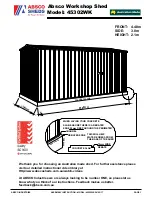
6
IMPORTANT NOTES BEFORE YOU BEGIN:
• Assemble your tent before camping to become familiar with the assembly.
• Setup is possible for one person, however two people are recommended.
• Select a clean, level area for the campsite free of debris and sharp objects, and away from a
natural watercourse.
• Use of a ground cloth is recommended to prolong the life of the tent floor and provide
additional insulation and moisture protection.
• To prevent damage to the zippers, unzip the doors and windows of the tent prior to
disassembly, allowing air to move freely.
• Seam sealing the inside stitched seams of the tent is recommended. This will improve weather
resistance. Discoloration may occur if applied to outside seams. (Seam sealer not included)
.
-
Your product must be stored dry. One of the easiest ways to damage your product is storing it
while it is wet. Storing a wet tent as briefly as 24 hours in warm weather is likely to cause mildew
on the fabric coatings.
-
If you must close camp in the rain, open your product and set it up to allow it to dry as soon as
possible. Allow dirt to dry on the fabric after a rainfall before lightly sweeping it off with a brush.
For tougher stains, spray the area with water and lightly wipe it off with a few strokes. Do not
use washer or dryer. DO NOT SCRUB THE FABRIC. ALWAYS MAKE SURE TENT IS COMPLETELY
DRY BEFORE REPACKING.
-
Do not leave your tent set up for weeks at a time. Exposure to ultraviolet rays from the sun
can damage and/or discolor the material.
-
Clean the poles with a cloth and lubricate them with a silicone spray to help prevent corrosion
and keep from becoming gritty. This is especially important after using the tent around salt water.
-
Store the stakes in a separate storage bag. Do not pack the stakes inside the tent.
Care and Maintenance

























